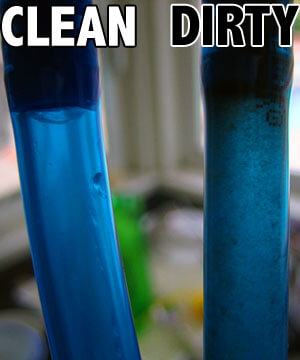 If you use a hydration pack then you are already familiar with the post ride cleaning ritual that must be completed in order to keep the system free and clear of slimy black deposits. These black deposits of fungus, mold, and bacteria that eventually form if you are not diligent in keeping them at bay with a good cleaning and drying of every part of the hydration pack system can definitely turn your next ride into a hurl fest faster than you can say raaalph. So, if the idea of drinking down those black spots of mucky-muck with every gulp of water isn't your idea of a good time than I suggest you do a few simple steps to maintain the bladder and hose of your hydration pack system, keeping it clean and clear and ready for your next ride.
If you use a hydration pack then you are already familiar with the post ride cleaning ritual that must be completed in order to keep the system free and clear of slimy black deposits. These black deposits of fungus, mold, and bacteria that eventually form if you are not diligent in keeping them at bay with a good cleaning and drying of every part of the hydration pack system can definitely turn your next ride into a hurl fest faster than you can say raaalph. So, if the idea of drinking down those black spots of mucky-muck with every gulp of water isn't your idea of a good time than I suggest you do a few simple steps to maintain the bladder and hose of your hydration pack system, keeping it clean and clear and ready for your next ride.First, clean the bladder. You can use a baby-bottle brush. I've found what works best is a long-handled foam paint brush. The point of the foam gets into the seams nicely. Don't use soap, unless you want to taste soap for the next month. Just use plain water for your routine cleanings.
For deeper cleaning, use a paste of sodium bicarbonate (Baking Soda) to remove stubborn deposits. To make the paste add just enough water to the baking soda so that it becomes mushy between your fingers. The sodium bicarbonate acts as an abrasive but will also kills germs and removes unusual tastes from the bladder such as that plastic flavor it has when it is new. If you are experiencing a particularly bad plastic taste you can soak the entire system (bladder with attached hose) overnight in a sodium bicarbonate solution (1 teaspoon of sodium bicarbonate to every 1 pint of water).
[caption id="attachment_8256" align="alignright" width="250"]
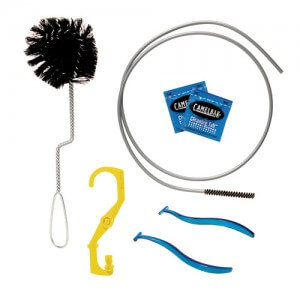 Some hydration pack manufacturers sell their own cleaning kit that includes a hose and bladder brush. Baking soda and lemon juice are inexpensive substitutes for cleansing tablets.[/caption]
Some hydration pack manufacturers sell their own cleaning kit that includes a hose and bladder brush. Baking soda and lemon juice are inexpensive substitutes for cleansing tablets.[/caption]Now sterilize the bladder. This slows down the regrowth of the black mucky-muck. Put 1/2 cup of lemon juice in the bladder and shake it around for a couple of minutes, allowing the juice to travel through every part of the bladder. Empty the bladder and rinse.
Now it's time to clean the drinking hose.
Step 1 - Pull the hose off the bladder, and pull the bite valve off the hose. I recommend you buy a tube-cleaning brush. That's a long stiff cable with a little brush on one end, made just to clean the inside of hydration bladder tubes. That's the best solution for a frequent rider. Quick and effective, with a tool made specifically for the job. But if you're cheap or only plan to clean the tube on rare occasions, here's a home-made tube cleaner suggestion from a bicycle mechanic: Use a derailleur cable.
Step 2 - Take a short piece of paper towel (NOT tissue paper). Get it slightly wet, then wrap it around the derailleur cable.
Step 3 - Spiral the paper towel a couple of inches up the cable, making sure it's narrow enough to fit into the tube opening. Slide the cable, with its paper towel coating, into the tube. (Don't pull on the tube yet.)

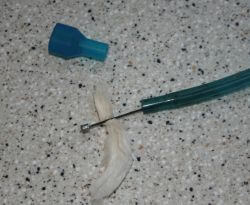
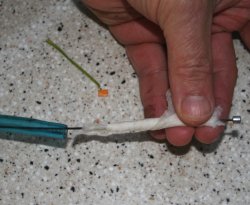
It may help to rotate as you push the paper towel-covered cable into the tube.
Step 4 - Once the knob is inside the tube, squish the tube with your fingers, just in front of the paper towel. Pull on the free end of the derailleur cable. The knob will compact the paper, expanding it so it tightly fills the tube. Now we're ready to clean!
Step 5 - Slowly pull the cable through the tube. As you come to obvious problem areas, again squish the tube somewhat, so the paper rubs hard against the inside of the tube.
Step 6 - Once the cable comes out the other end, discard the paper and reinsert the cable with a fresh piece of paper towel. Repeat the process until the paper towel comes out clean and your drinking hose looks clear.
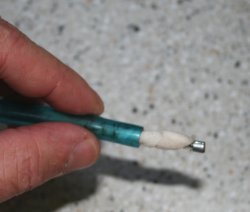

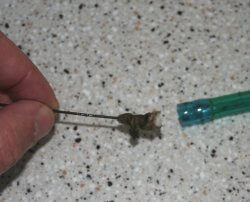
Step 7 - Reattach the bite valve to the hose and the hose to the bladder. You are done!
Note: If you use only water in your hydration system you will have less of a problem with keeping it clean. If you use an electrolyte drink mix, you're going to get black mucky-muck growing in your hydration pack no matter how carefully you rinse it after each use.
Caution: One way of slowing the growth of mold is to let the hydration pack sit for a day with a very dilute bleach solution (one teaspoon of bleach in an entire bladder of water). Rinse well afterward. This will inhibit growth of black mucky-muck for a couple of months but it will make your water taste like bleach. This bleach taste will be difficult to remove from the bladder and hose.













